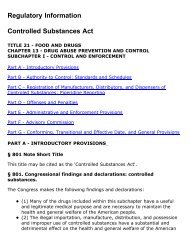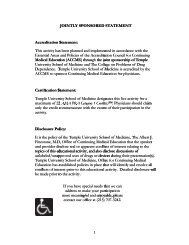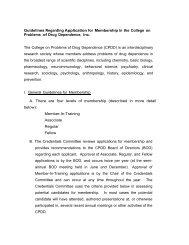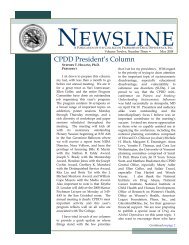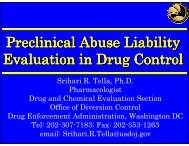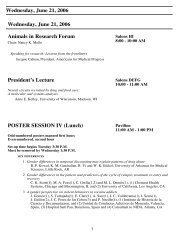CPDD 72nd Annual Meeting • Scottsdale, Arizona - The College on ...
CPDD 72nd Annual Meeting • Scottsdale, Arizona - The College on ...
CPDD 72nd Annual Meeting • Scottsdale, Arizona - The College on ...
Create successful ePaper yourself
Turn your PDF publications into a flip-book with our unique Google optimized e-Paper software.
29<br />
EFFECT OF ACUTE AMPHETAMINE ON EMOTIONAL<br />
MEMORY.<br />
Michael E Ballard, G Bedi, D A Gallo, H de Wit; Psychiatry and Behavioral<br />
Neuroscience, University of Chicago, Chicago, IL<br />
Aims: This study is designed to assess the effects of a stimulant drug <strong>on</strong> emoti<strong>on</strong>al<br />
memory. Drugs of abuse act <strong>on</strong> neural substrates of learning and memory,<br />
which play a central role in addicti<strong>on</strong>. A positive sober memory recollecti<strong>on</strong> for<br />
experiences encountered during intoxicati<strong>on</strong> is likely to c<strong>on</strong>tribute to repeated<br />
use. Amphetamine (AMP), a prototypic stimulant drug of abuse, enhances memory<br />
for motivated behaviors in animal models (i.e. shock avoidance, food<br />
reward). In humans, AMP can improve memory for paired word associates and<br />
noun word lists. However, its effects <strong>on</strong> memory for emoti<strong>on</strong>al c<strong>on</strong>tent have not<br />
been examined. We hypothesized that AMP would preferentially enhance memory<br />
for emoti<strong>on</strong>al material. Further, we investigated whether AMP facilitates<br />
memory in c<strong>on</strong>cert with, or independently of, its effects <strong>on</strong> subjective arousal<br />
state. AMP may improve memory through its ability to produce euphoria, which<br />
may result in mood-c<strong>on</strong>gruent processing and positive memory biases.<br />
Methods: Healthy human volunteers (N=24; 18-35yrs) receive d-AMP (10mg,<br />
20mg, or placebo p.o.) <strong>on</strong> three study sessi<strong>on</strong>s, before viewing positive, negative,<br />
and neutral photographs and pers<strong>on</strong>ality trait words. Subjects rate stimuli for<br />
valence and arousal, and recogniti<strong>on</strong> memory is assessed 48 hrs later, while sober.<br />
Ratings of stimulus percepti<strong>on</strong>, memory improvement, or bias are examined in<br />
relati<strong>on</strong> to subjective mood states and drug preference after drug and placebo.<br />
Results: Preliminary results (N=13) suggest that AMP improves memory accuracy<br />
for positive > negative photographs, with no improvement seen for neutral<br />
photographs or trait words. <str<strong>on</strong>g>The</str<strong>on</strong>g>se effects appear to be independent of AMPinduced<br />
changes in arousal state and perceptual alterati<strong>on</strong>s.<br />
C<strong>on</strong>clusi<strong>on</strong>s: AMP-induced preferential enhancement of subsequent sober<br />
memory for emoti<strong>on</strong>al material was found, with the greatest improvement seen<br />
for c<strong>on</strong>tent perceived as positive. This profile may be an important factor influencing<br />
repeated use, particularly c<strong>on</strong>sidering that AMP is often used with the<br />
intenti<strong>on</strong> of inducing a positive mood state or enhancing celebratory situati<strong>on</strong>s.<br />
Financial Support: NIDA DA02812 and T32 DA007255<br />
31<br />
PRENATAL COCAINE EXPOSURE AND MEMORY AND<br />
LEARNING DEFICITS IN EARLY ADOLESCENCE: MALE-<br />
FEMALE DIFFERENCES.<br />
Emmalee S Bandstra 1 , V H Accornero 1 , E Mansoor 1 , C E Morrow 1 , A Y Ofir 1 , J<br />
C Anth<strong>on</strong>y 2 , L Xue 1 ; 1 Pediatrics, University of Miami Miller School of Medicine,<br />
Miami, FL, 2 Epidemiology, Michigan State University, East Lansing, MI<br />
Aims: To assess whether prenatal cocaine exposure (PCE) is associated with<br />
memory and learning deficits in early adolescence, with a specific focus <strong>on</strong> possible<br />
sex/gender differences.<br />
Methods: This study was c<strong>on</strong>ducted in a subsample of the Miami Prenatal<br />
Cocaine Study (MPCS), a large single-site l<strong>on</strong>gitudinal study. <str<strong>on</strong>g>The</str<strong>on</strong>g> prospectively<br />
enrolled birth cohort c<strong>on</strong>sisted of 476 full-term African American infants (127<br />
girls/126 boys with PCE and 112 girls/111 boys without PCE). Serial multidomain<br />
assessments have been c<strong>on</strong>ducted. At the 12-year visit, 85% of the original<br />
cohort completed the Wide Range Assessment of Memory and Learning<br />
(WRAML). Using structural equati<strong>on</strong>s modeling (SEM), a memory-learning<br />
latent c<strong>on</strong>struct was regressed <strong>on</strong> PCE, with separate models for males and<br />
females, and with the ‘multiple indicators, multiple independent causes’<br />
(MIMIC) model used to estimate possible differential PCE effects <strong>on</strong> memorylearning<br />
subfacets.<br />
Results: With test age held c<strong>on</strong>stant, there was a PCE-associated deficit in the<br />
latent memory-learning c<strong>on</strong>struct (n=405; p



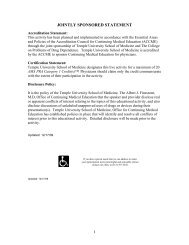
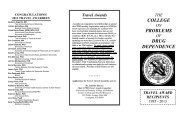
![2013SYMP AND WORKSHOP LIST[web]](https://img.yumpu.com/35325424/1/190x245/2013symp-and-workshop-listweb.jpg?quality=85)
